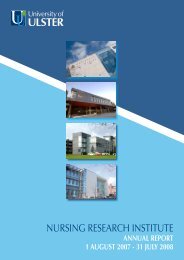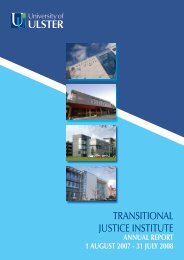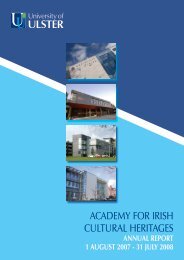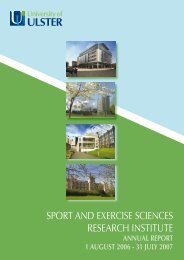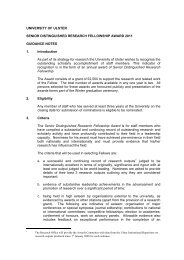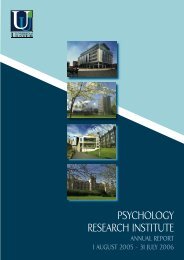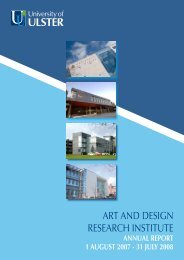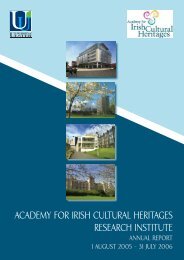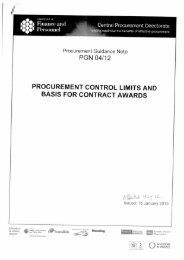environmental sciences research institute - University of Ulster
environmental sciences research institute - University of Ulster
environmental sciences research institute - University of Ulster
Create successful ePaper yourself
Turn your PDF publications into a flip-book with our unique Google optimized e-Paper software.
4. Research Projects in Environmental Science<br />
4.1 CENTRE FOR MARITIME ARCHAEOLOGY (CMA)<br />
RESEARCH FOCUS<br />
CMA <strong>research</strong> is focused on maritime cultural landscapes, directed under three themes – coastal and freshwater<br />
landscapes, historical archaeology and marine geoarchaeology. Over the past 12 months, we have continued to<br />
develop landscape models concentrating on aspects <strong>of</strong> settlement, exploitation, defence and communication within<br />
coastal environments <strong>of</strong> Ireland, Britain and East Africa. Historical archaeology <strong>research</strong> has primarily focused on<br />
the Later-Medieval and Post-Medieval periods <strong>of</strong> Ireland and Scotland, examining issues relating to Gaelic Lordship<br />
and coastal economies. Research in marine geoarchaeology has focused on physical processes <strong>of</strong> shipwreck site<br />
formation, geophysical signatures <strong>of</strong> submerged and buried archaeological materials and past human responses to<br />
significant sea-level change.<br />
RESEARCH OUTPUT<br />
Research Monographs<br />
Harnessing the Tides: The Early Medieval Tide Mills at Nendrum<br />
Monastery, Strangford Lough (The Stationery Office, 2007) authored by<br />
Thomas McErlean and Norman Crothers. This monograph details the excavation <strong>of</strong><br />
two Early Medieval monastic tide mills, one <strong>of</strong> which is the earliest recorded in the<br />
world. The publication contextualises the history and archaeology <strong>of</strong> the important<br />
Early Medieval monastery <strong>of</strong> Nendrum, located on an island in Strangford Lough,<br />
Co. Down.<br />
An Archaeology <strong>of</strong> Southwest Ireland, 1570–1670 (Four Courts Press,<br />
2007) authored by Colin Breen. The 17th century was a period <strong>of</strong> significant political<br />
and religious upheavals and was also a formative period in terms <strong>of</strong> landscape and<br />
settlement development throughout Ireland. This book examines Munster from an<br />
historical archaeology perspective. In particular the study sets the archaeological<br />
context <strong>of</strong> these developments against the historical background <strong>of</strong> plantation,<br />
Cromwellian intervention and economic expansion.<br />
Maritime Ireland: An Archaeology <strong>of</strong> Coastal Communities (Tempus,<br />
2007) authored by Colin Breen and Aidan O’ Sullivan from <strong>University</strong> College<br />
Dublin. Ireland is an island in the Atlantic Ocean yet, while archaeologists, historians<br />
and historical geographers have commonly accepted this island status, they have<br />
rarely explored the role <strong>of</strong> the sea in the development <strong>of</strong> the cultures and societies<br />
<strong>of</strong> this land. The authors explore the material evidence for maritime life and<br />
traditions <strong>of</strong> Ireland from 7000 BC to the present day.



